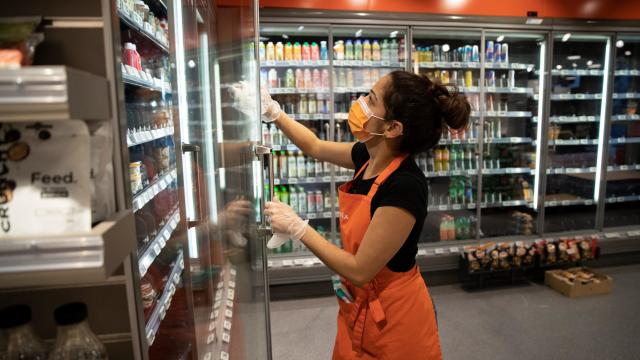The world’s food system is a major source of greenhouse gas pollution, from the emissions caused by farming and ranching to those released by the planes, trains, and trucks used to transport groceries. A new report shows the freezer aisle in the grocery store could also be an even bigger source of pollution than we thought.
Most cooling technology emits greenhouse gases called hydrofluorocarbons (HFCs), which have thousands of times more heating potential than carbon dioxide. Environmental Investigation Agency, an environmental advocacy nonprofit, conducted an undercover study using industry-standard leak sensors to detect HFC emissions at 45 big-box chain supermarkets in Washington, D.C., Maryland, and Virginia. The group also used an infrared camera to make the illicit leaks visible to the human eye. (You can check out this video to see an example from a Giant grocery store.) The investigation focused mostly on Walmart because is the largest retailer in the U.S., but also examined other chains, including ALDI, Safeway, Trader Joe’s and Whole Foods.
The authors found that more than half of the stores they surveyed were emitting HFCs. Of the 20 Walmarts the investigators visited, they detected HFC pollution at 60% of them. They documented leaks at 55% of the other supermarkets they visited, “consistent with concerns that refrigerant leaks are an industry-wide problem,” the report says.
The amount of pollution the sensors picked up varied widely, from as little as 2 parts per million (ppm) to 182 ppm. But according to the company Bacharach, which manufactured the leak detectors the investigators used, even a 2 ppm reading can indicate a bigger problem.
“Always keep in mind that leaks are going to be a dispersion, so 2 ppm in [one location] could be a much greater leak as the air mixes and disperses throughout the unit,” an instructional video from the company says.
The leaks occurred despite promises from some of the chains to get a handle on refrigerant pollution. In 2010, for instance, Walmart as well as other mega-retailers signed the Consumer Goods Forum Refrigerant Resolution to begin phasing out HFCs starting in 2015. But it’s not clear if they’ve made any progress, since the firm’s 2020 Environmental, Social, and Governance report made no mention of refrigerant-related goals.
Last September, the company seemingly redoubled its efforts, promising that it is “transitioning to low-impact refrigerants for cooling and electrified equipment for heating in its stores, clubs, and data and distribution centres by 2040.” But as the new report notes, the promise is vague.
“In this announcement, ‘low-impact refrigerants,’ are not defined, nor are any intermediary goals over the next two decades to achieve these objectives,” the authors of the report wrote. “Walmart also failed to offer a plan to address current leaks of HFCs from its stores in its announcement.”
U.S. retailers’ procrastination is having an awful climate impact. New data from the U.S. Environmental Protection Agency released Friday shows that national HFC pollution increased by 4 million metric tons between 2018 and 2019. Supermarkets aren’t the only source of these emissions or the increase; HFCs are commonly used in many industries as well as home air conditioning. Still, according to previous Environmental Investigation Agency report based on EPA data, the country’s tens of thousands of supermarket grocery stores’ HFC refrigerants produce as much global warming pollution annually as burning 49 billion pounds (22 billion kilograms) of coal.
Without big changes, federal projections indicate that HFCs will be the equivalent of up to 19% of carbon dioxide emissions by 2050. But it doesn’t have to be that way. We have the technology to change course right now. Alternative coolants with far less climate impact, like carbon dioxide, propane, and ammonia are already on the market. There are already some 600 supermarkets across the U.S. that use exclusively HFC-free refrigerants, but the nation is lagging far behind progress in other parts of the world. Europe, for instance, already has 26,000 supermarkets that use these technologies.
According to the EPA, addressing HFC emissions is the nation’s single largest opportunity for climate change mitigation. Thankfully, it seems the U.S. may finally getting serious about regulating these super-polluting chemicals out of use, though. In December, Congress passed a plan to rapidly phase down production and use of HFCs. And last month, President Joe Biden directed his government to join the Kigali Amendment, an international agreement to stop using the refrigerant chemicals by mid-century.
